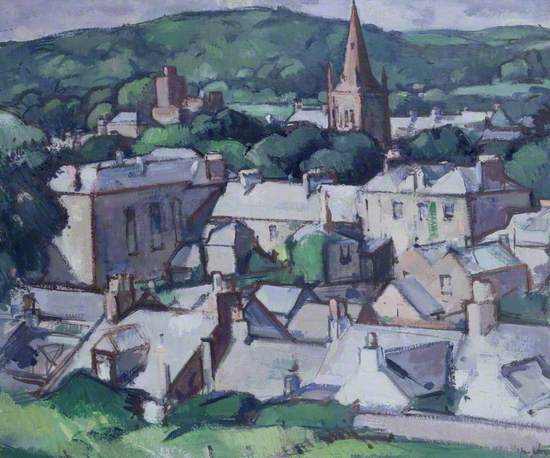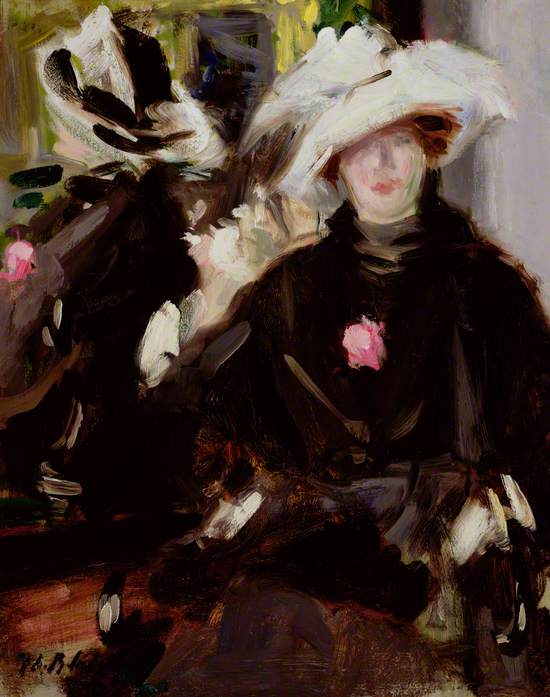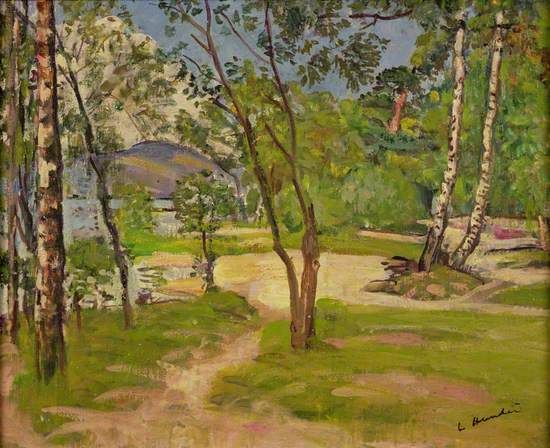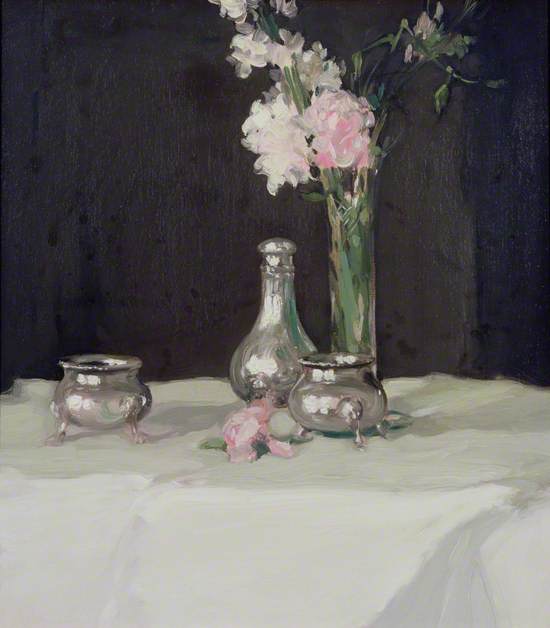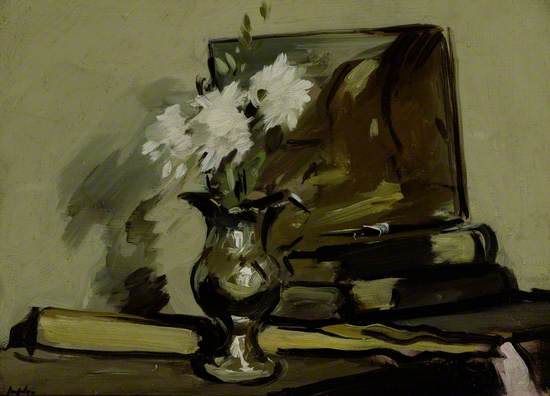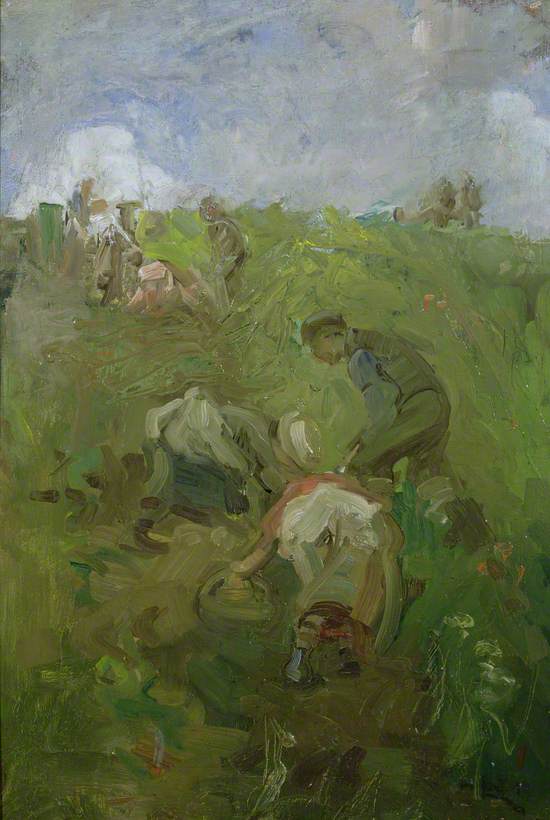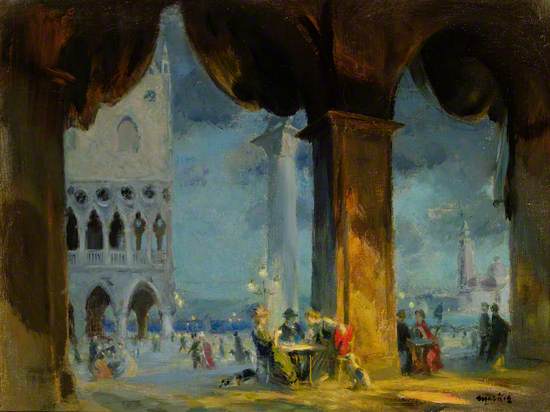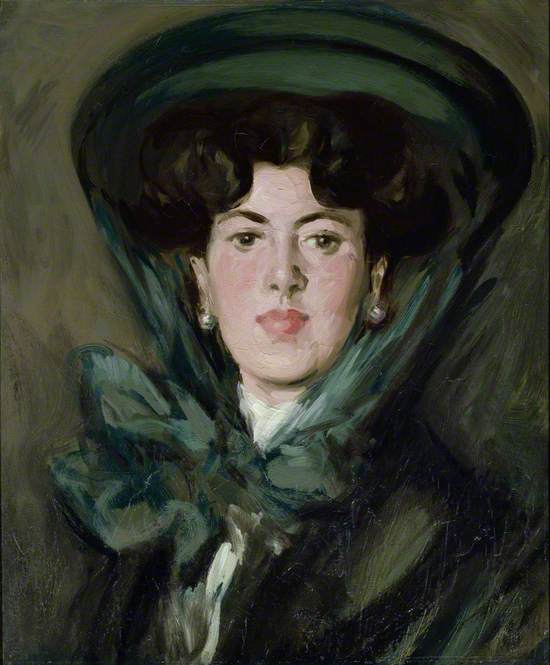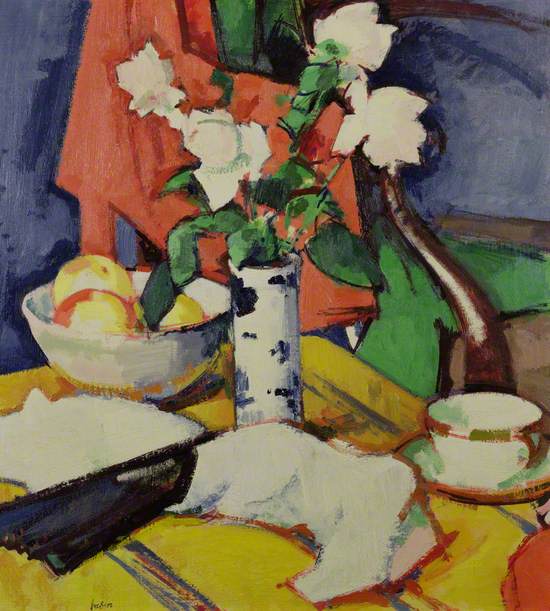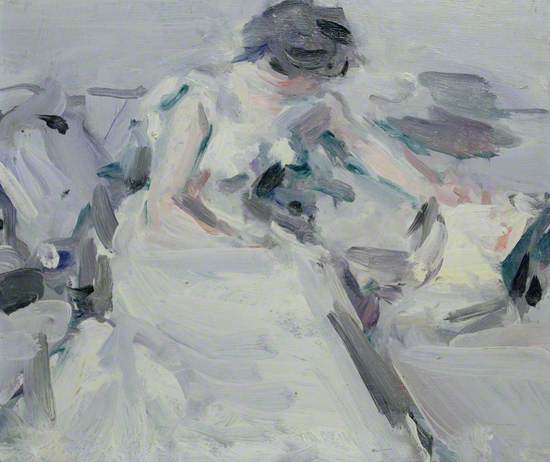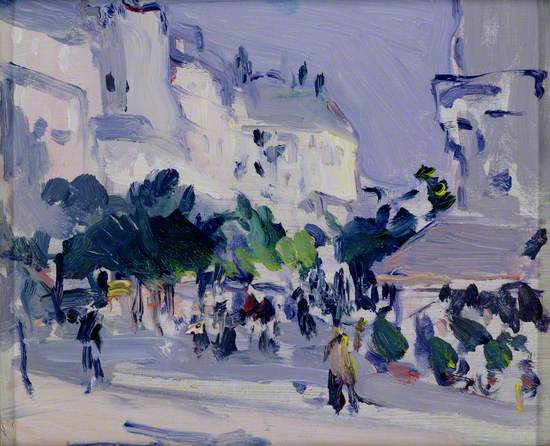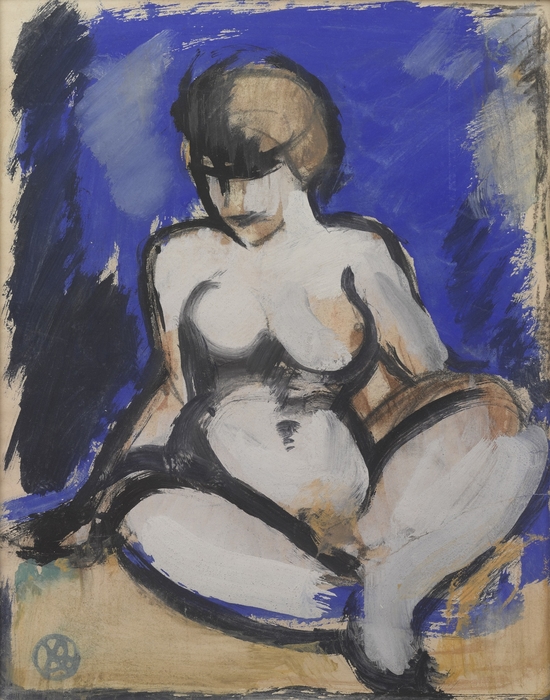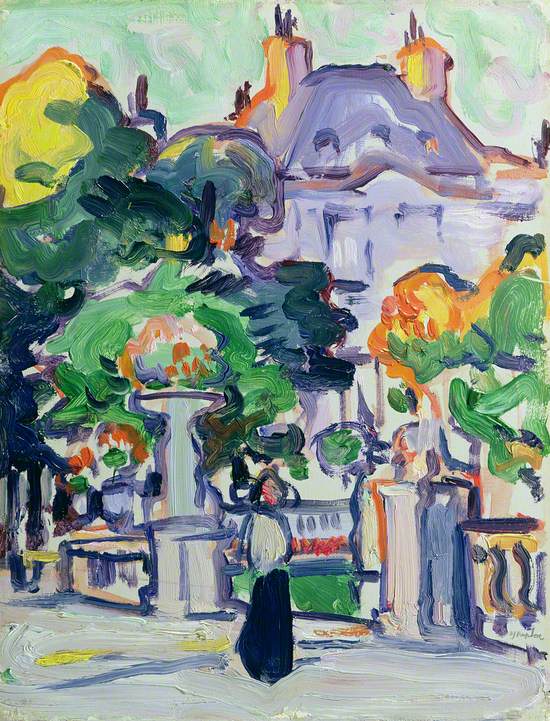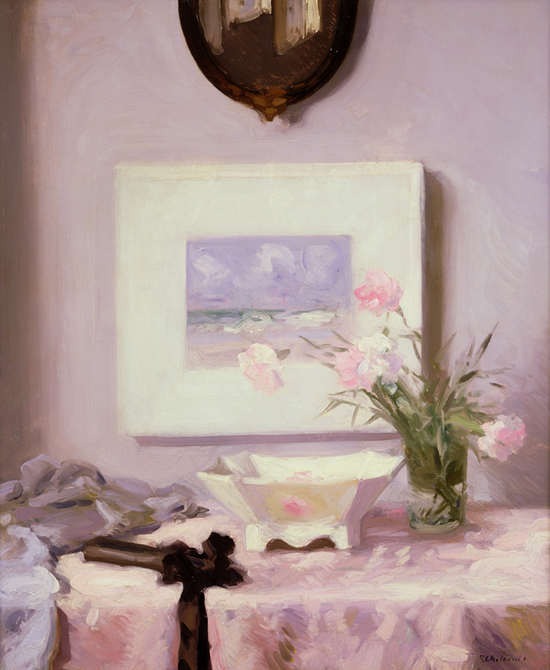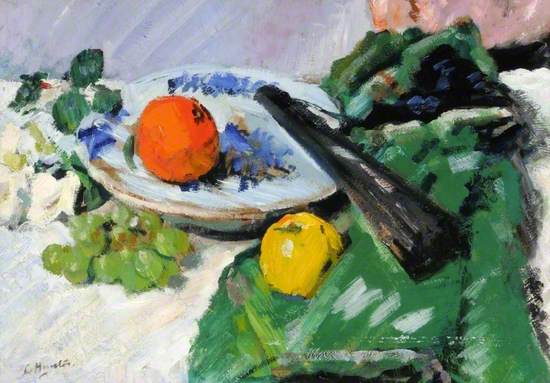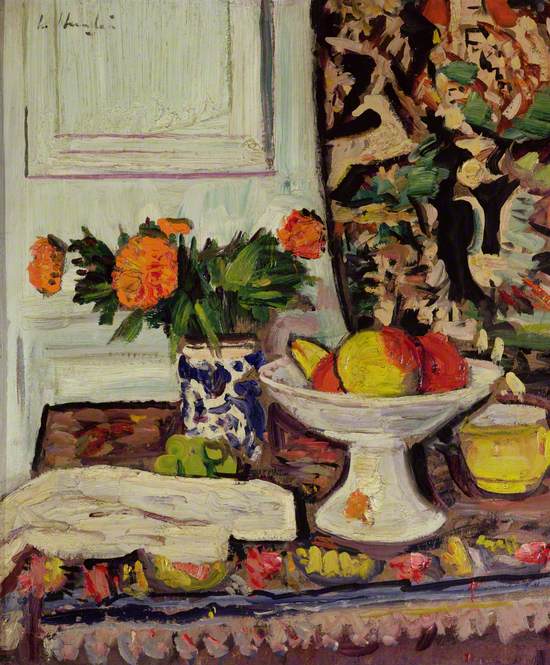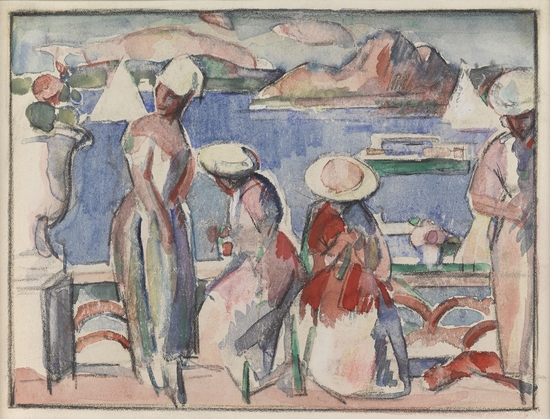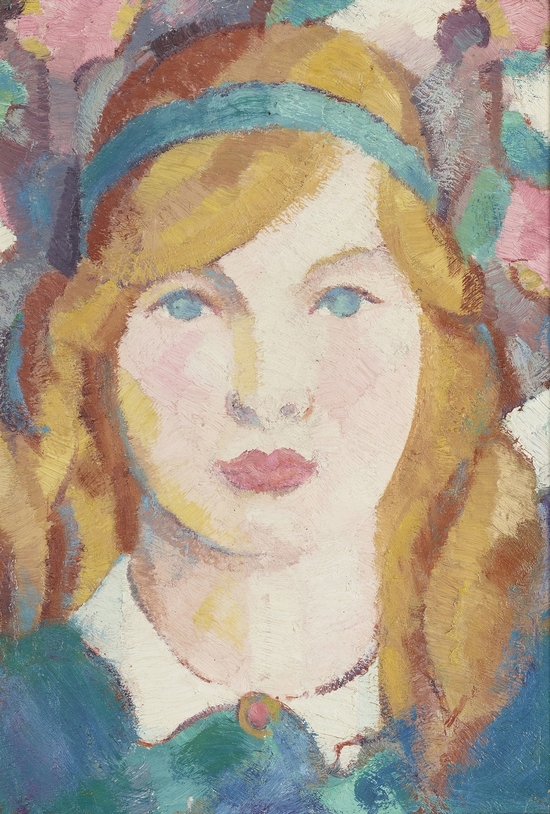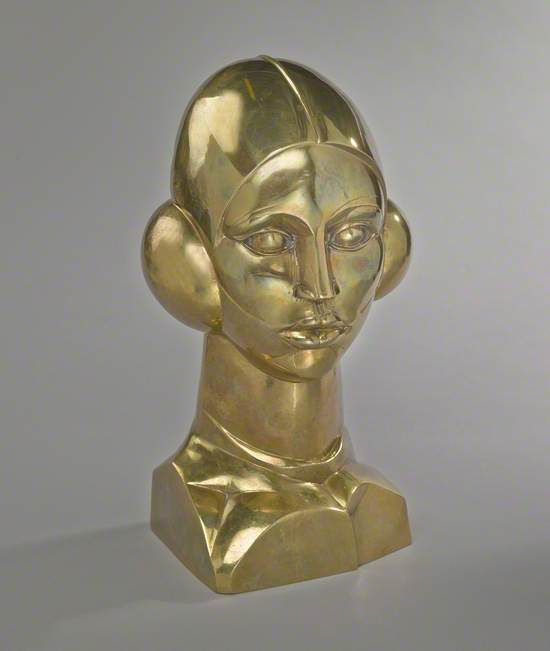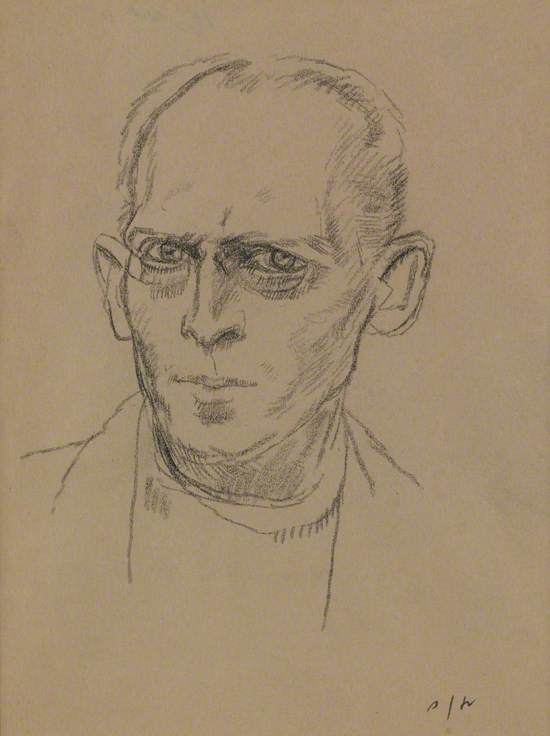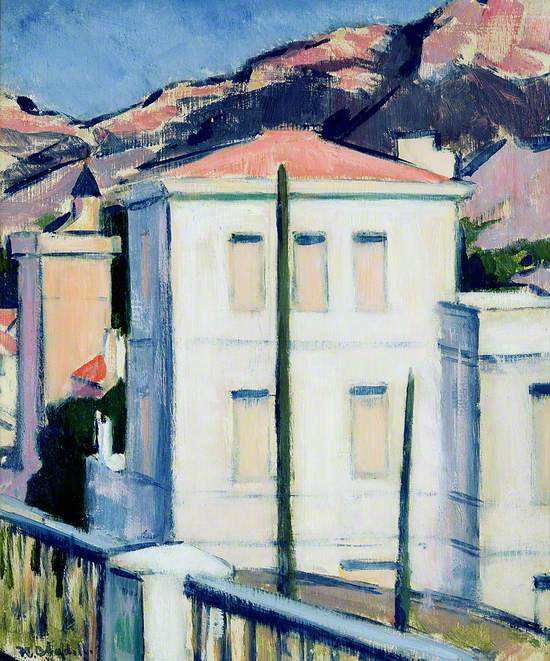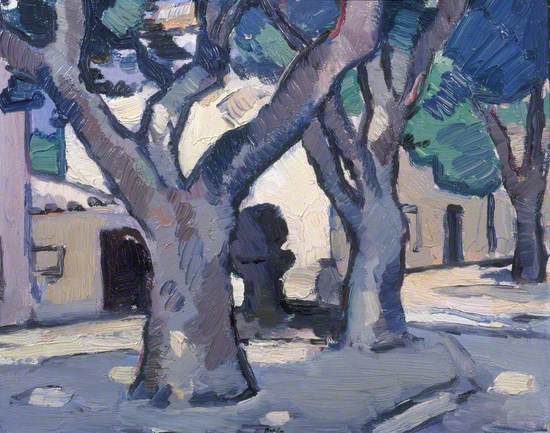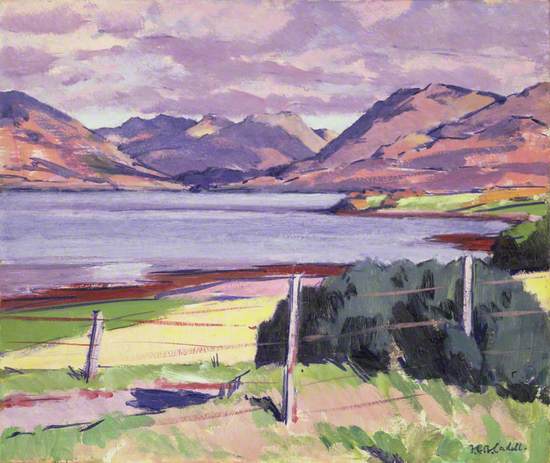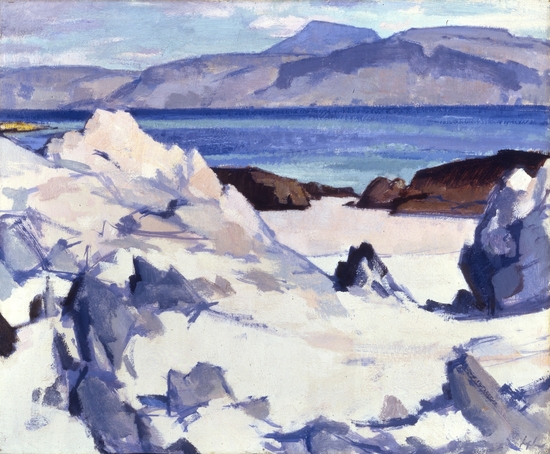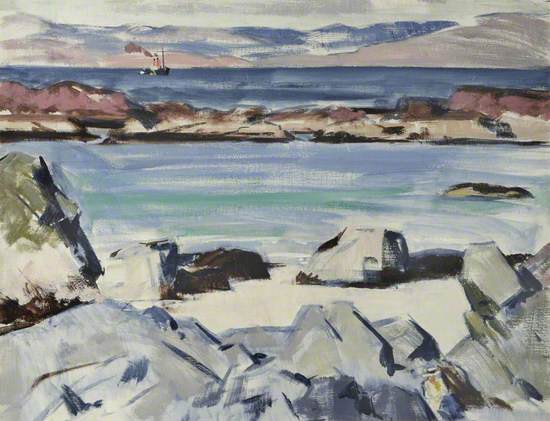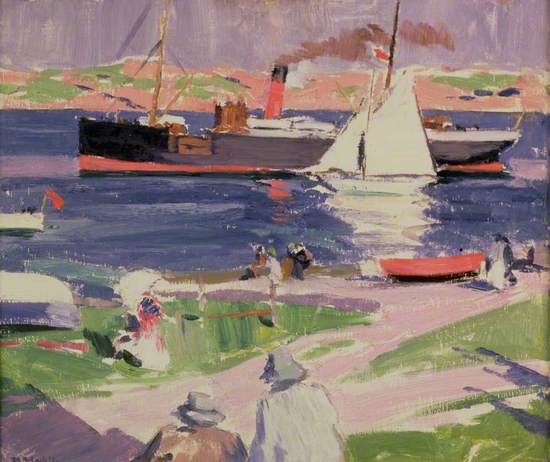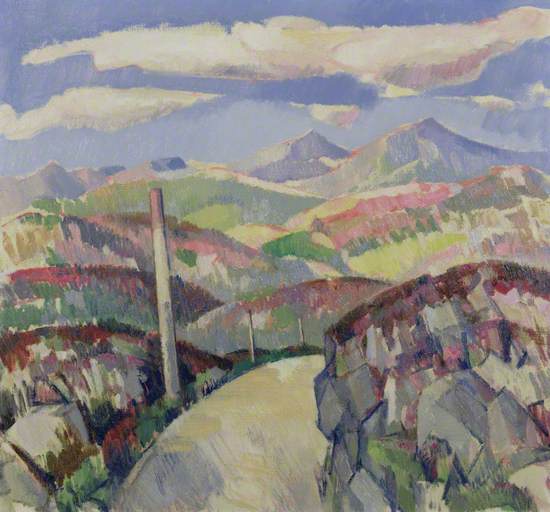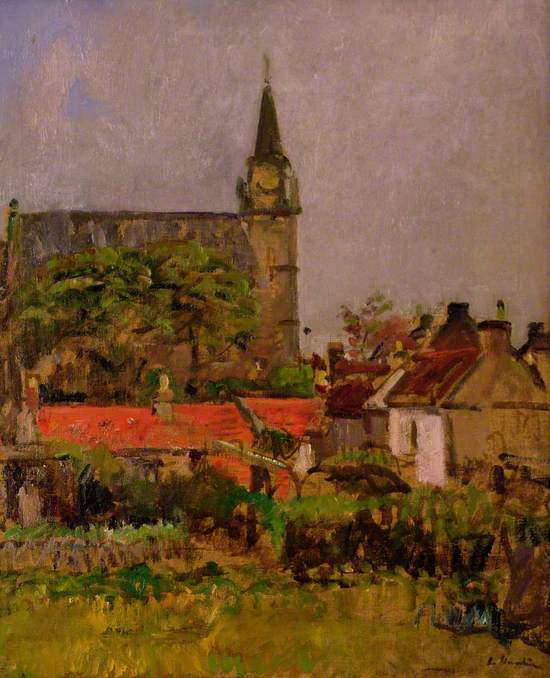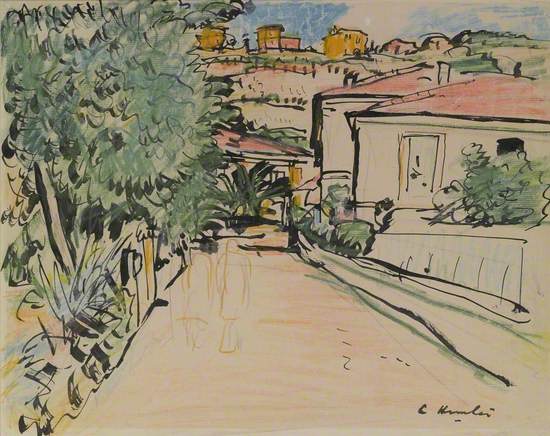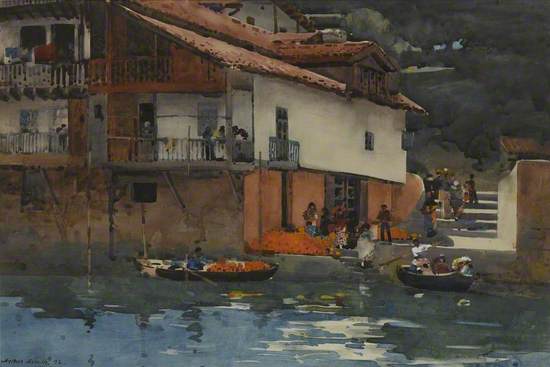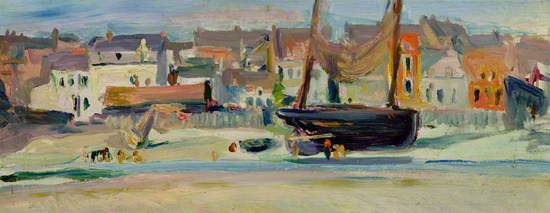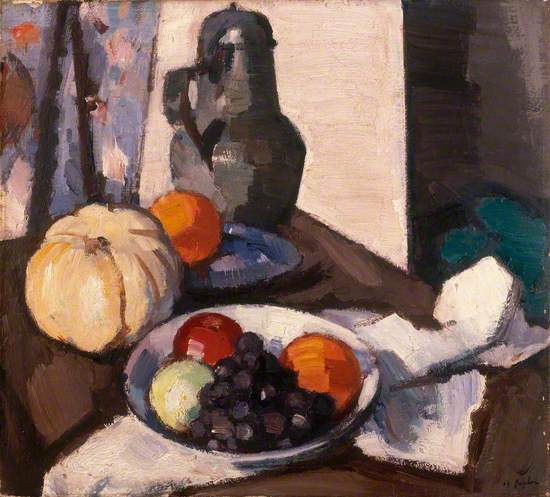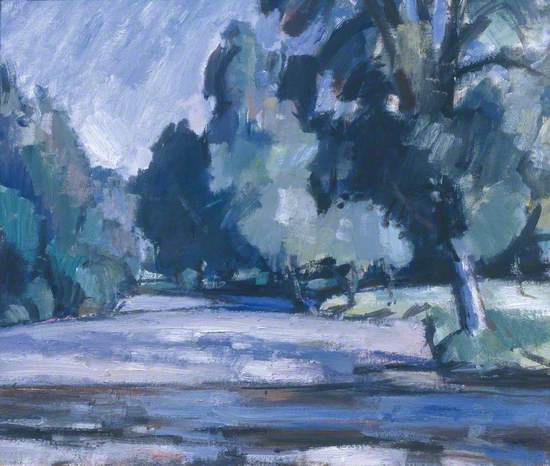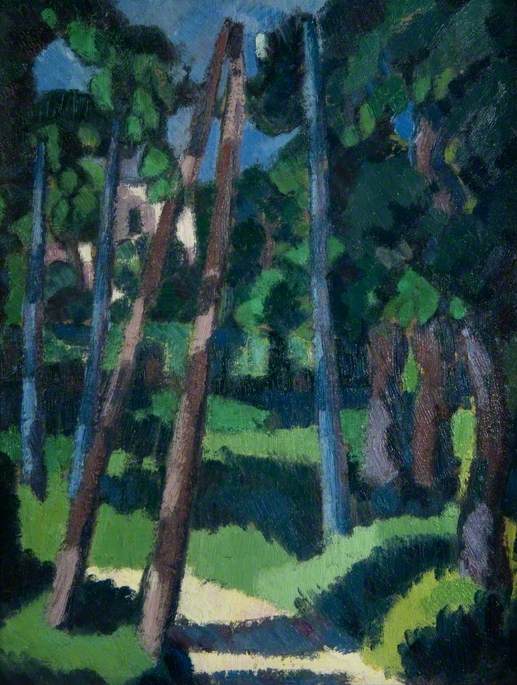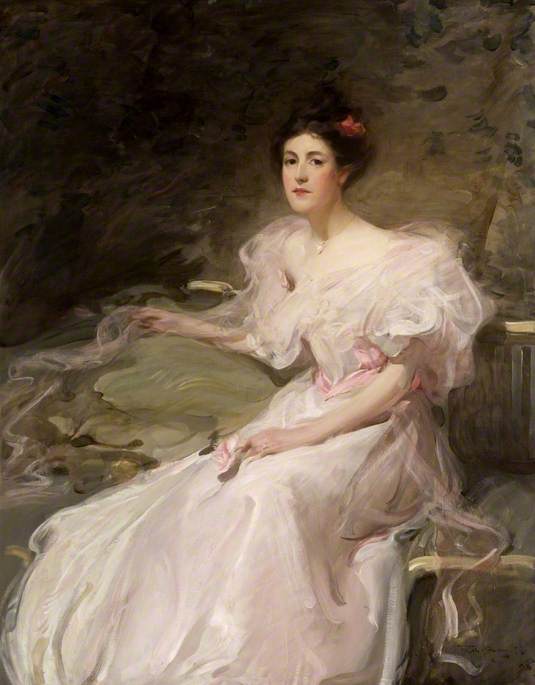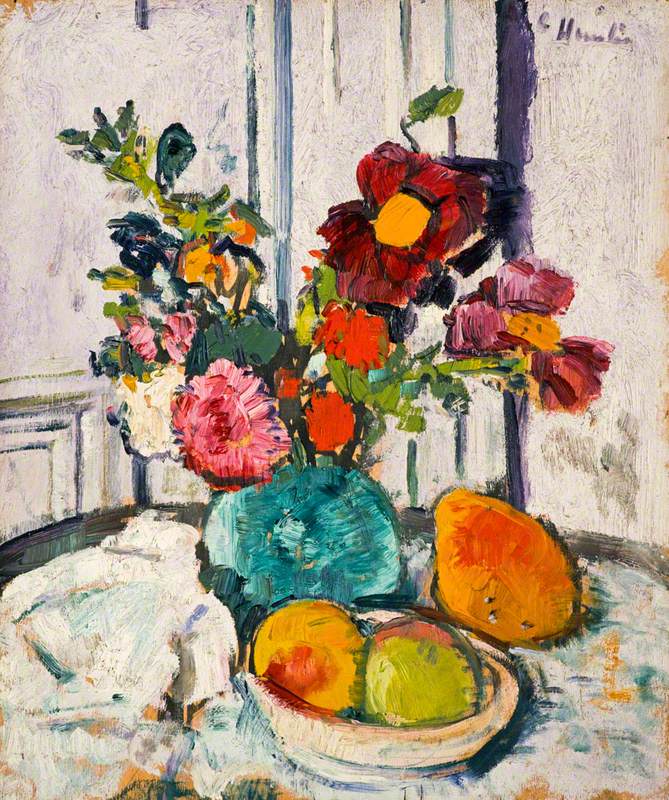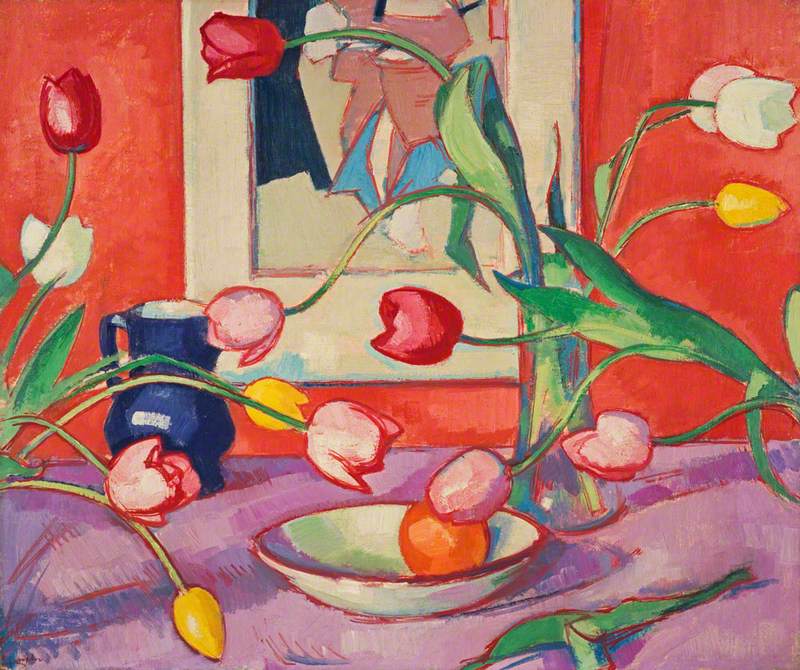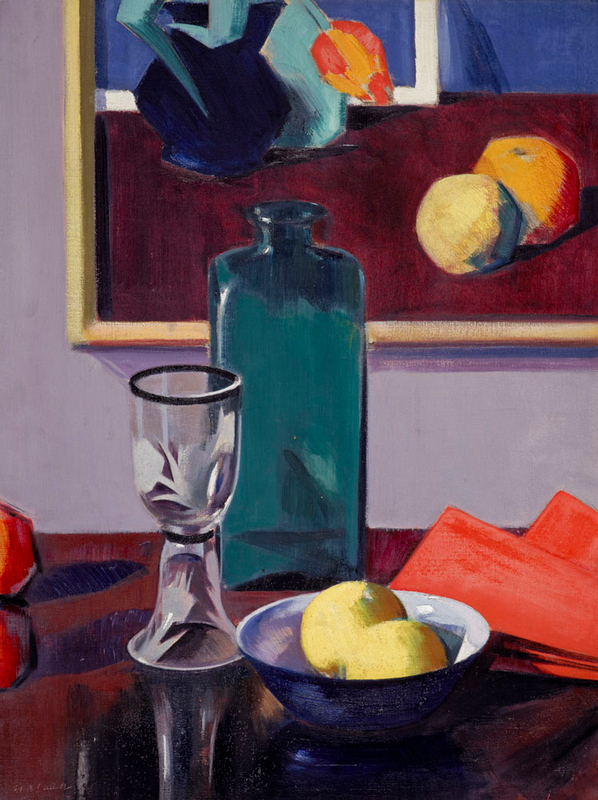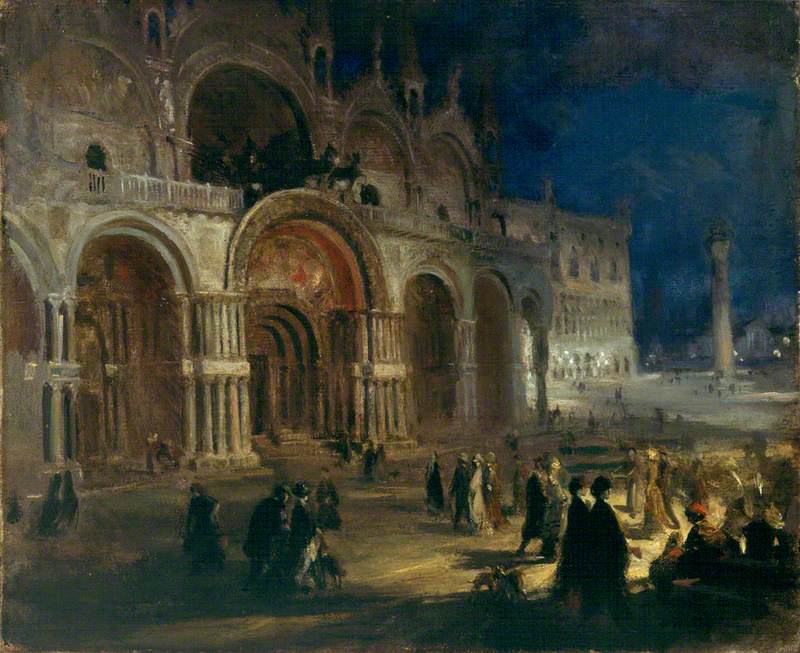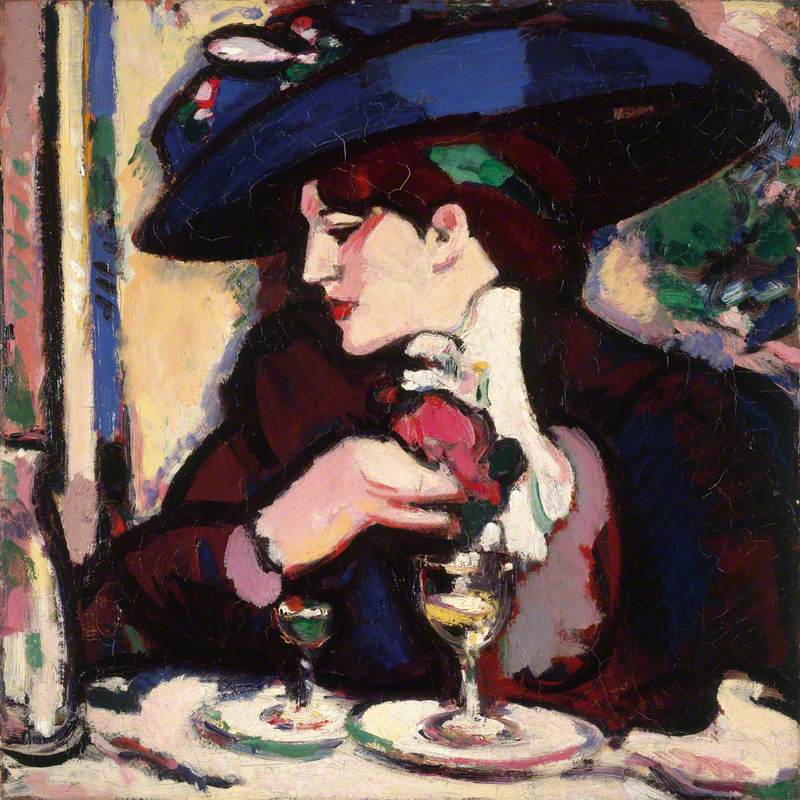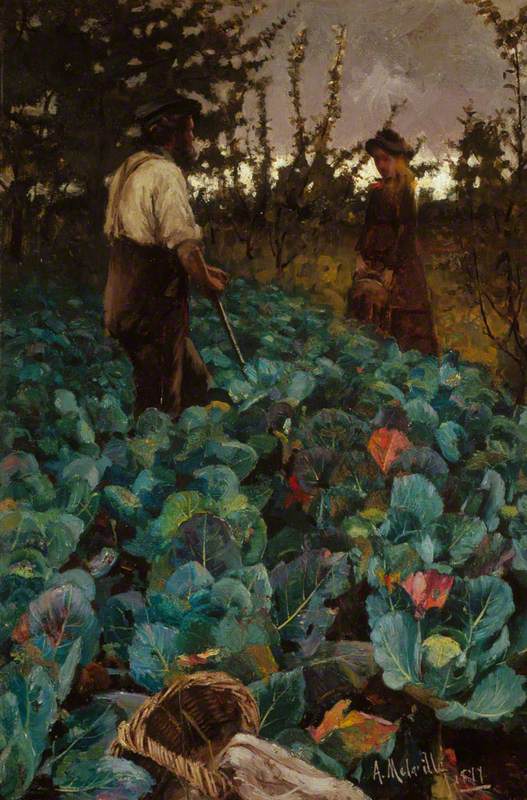The four artists known as the Scottish Colourists, S.J. Peploe, J.D. Fergusson, Leslie Hunter, and F.C.B. Cadell are acknowledged as one of the most talented, experimental and distinctive groups in 20th century British art.
Emboldened by the creativity of Post-Impressionist giants, Cézanne, Van Gogh and more, these young Scots explored the frontiers of contemporary art through a cutting-edge use of pure colour and line.
Colour and Light: Scottish Colourists from the Fleming Collection traces the development of the Scottish Colourists, from their precocious beginnings to the maturity of their later works.
The exhibition is on display at the Graves Gallery in Sheffield until 9 December 2023.
Edinburgh-born Peploe established his artistic reputation with a series of commercially successful still lifes and portrait studies. During the First World War, however, Peploe sought a new challenge. ‘I am finished with the colour block system’ he wrote to Cadell ‘and await a new development’.
In 1915, Peploe made the first of a number of visits to Kirkcudbright. His paintings of the picturesque Scottish town emphasise the geometry of its architecture and, in doing so, reveal Paul Cézanne’s (1839-1906) influence on Peploe’s analysis of form, colour and tone.
Samuel John Peploe (1871–1935)
Oil on canvas
H 53.3 x W 63.5 cm
The Fleming Collection
In 1898, aged 16, Cadell left Edinburgh to attend art school in Paris where he stayed on and off until 1905. His early exposure to the Impressionists underlies the technical freedom of his early work.
Cadell returned to Edinburgh around 1909 and embarked on a series of portraits of elegant women in his New Town studio. The Feathered Hat is one such portrait and shows his preoccupation with the possibilities of mirrored reflections and the tonal effects of black and white.
Francis Campbell Boileau Cadell (1883–1937)
Oil on millboard
H 45.7 x W 35.5 cm
The Fleming Collection
Born into a well-to-do family from the Isle of Bute, Hunter established himself as an accomplished illustrator before turning his hand to painting. His artistic flair resulted in some of Scottish Colourists’ most individual and authentic works.
Hunter first visited Loch Lomond in 1924 where the colourful houseboats inspired a series of works in homage to Henri Matisse (1869-1954). His luminous paintings, such as Loch Lomond, distil the lessons of his lifelong search for the balance of colour, light and form.
George Leslie Hunter (1877–1931)
Oil on canvas
H 45.7 x W 55.8 cm
The Fleming Collection
Born in Edinburgh, Fergusson’s youthful determination to become an artist was bolstered by time spent studying in Paris in the 1890s. Upon returning to Edinburgh he developed a close friendship with Peploe who shared his enthusiasm for contemporary French masters, such as Édouard Manet (1832-1883) and Claude Monet (1840-1926).
Jonquils and Silver was painted at a time when Fergusson and Peploe were almost inseparable and illustrates their shared passion for the dazzling tonal effects pioneered by James McNeill Whistler (1834-1903).
John Duncan Fergusson (1874–1961)
Oil on canvas
H 50.8 x W 45.7 cm
The Fleming Collection
Beginning with Friendship
This gritty, roughly painted work illustrates Peploe's admiration for the work of Édouard Manet (1832-1883), whose work he would have known well from exhibitions in Paris.
Like many of Peploe’s still lifes of this period, Flowers in a silver jug was executed in line with Manet’s technique of first painting in the light areas, adding darker tones later while the paint was still wet.
It was these still lifes which established Peploe’s early reputation.
Samuel John Peploe (1871–1935)
Oil on panel
H 25.4 x W 34.9 cm
The Fleming Collection
The now largely forgotten Robert Brough met Peploe in 1892 at the Royal Scottish Academy schools and they soon became firm friends. They moved to Paris in 1894, sharing accommodation and enrolling at the Académie Julian. Here, they soaked up the latest artistic trends.
The loose brushwork and muted tones of Fieldworkers reflect the youthful technique of the precocious young talents, revealing their closeness and ambition as artists.
Charles Hodge Mackie was finely attuned to artistic innovation in both France and Scotland. He was also a great supporter of young artists, such as Peploe, Cadell and Fergusson. As a founder member of the Society of Scottish Artists he encouraged the acquisition of their work for Scottish national collections.
Mackie visited Venice for the first time in 1908 and was immediately attracted to the city’s impressive architecture. In this painting Mackie captures an atmospheric evening scene from beneath the great arches.
Charles Hodge Mackie (1862–1920)
Oil on canvas
H 38.1 x W 50.8 cm
The Fleming Collection
This portrait shows Fergusson’s lover and first muse, Jean Maconochie. Her scarf is tied with a flourish under her chin, while her elaborate hat towers dramatically atop her curled hair.
The dramatic lighting and free brushwork seen here reflects the influence of John Lavery (1856-1941). Lavery was a fashionable portrait artist who, like Fergusson, was inspired by James McNeill Whistler (1834-1903) in his use of delicate colour harmonies and tonal qualities.
John Duncan Fergusson (1874–1961)
Oil on canvas
H 60.9 x W 50.8 cm
The Fleming Collection
Peploe’s move to a new studio in Edinburgh in 1917 prompted a change of direction as he embarked on a quest to achieve the perfect still life.
His meticulous arrangements of tulips, roses, fabrics and other stylish props often took days to achieve. The painting, by comparison, was finished quickly within one sitting. He worked on canvasses primed with an absorbent gesso ground, which prevented re-working.
Peploe’s technical accomplishment and profound understanding of the power of colour brought him commercial and critical success.
Experimenting with Colour
In 1905 Peploe moved into a new Edinburgh studio at 32 York Place. The walls were painted pale grey with a hint of pink and the floor laid with black linoleum. The light drenched space was the setting for a series of loosely painted figure studies of the model Peggy Macrae.
Inspired by James McNeill Whistler’s (1834-1903) female portraits in white, the emphasis of Peploe’s Lady in a White Dress is on the arrangement of colour, rather than the subject matter.
Samuel John Peploe (1871–1935)
Oil on panel
H 30.4 x W 35.5 cm
The Fleming Collection
From around 1904, Peploe and Fergusson made annual expeditions to fashionable resorts on the Normandy coast such as Paris-Plage (now Le Touquet). Here they painted on the beach equipped with pochades, small wooden paint boxes which carried panels slotted into the lid which served as an easel.
As time went on, these plein air sketches, originally painted in rich creamy tones, became bolder in colour and more vigorously handled. This development suggested an awakening to contemporary developments in France, led by the Fauves.
Samuel John Peploe (1871–1935)
Oil on board
H 21.5 x W 26.6 cm
The Fleming Collection
Fergusson moved to Paris in 1907 where he was exposed to the full force of the European avant-garde. An intense period of experimentation followed. He deserted the subdued tones of realist painting in favour of two-dimensional planes of pure colour and bold outline.
The energy and potency of Blue Nude reflects this European influence. His use of expressive black outlines reveals his debt to Kees Van Dongen (1877-1968), while the spontaneous brushwork owes much to Henri Matisse’s (1869-1954) notorious nude paintings.
John Duncan Fergusson (1874–1961)
Gouache on paper (?)
H 30.5 x W 24.8 cm
The Fleming Collection
Peploe’s move to France in 1910 marked a turning point. Over the previous five years, his annual visits had brought him into contact with the Fauves and the emerging giant of modern art, Vincent van Gogh (1853-1890). Their influence unlocked the reserved Scot’s wild side, inspiring his use of primary colours, often applied directly from the tube.
Luxembourg Gardens reveals his surrender to the raw expressionism of the Fauves and to the vivid palette and technical accomplishment of Van Gogh.
Samuel John Peploe (1871–1935)
Oil on wood panel
H 35.6 x W 27.9 cm
The Fleming Collection
The Quartet Assembles
In 1909 Cadell moved into his first studio at 130 George Street, Edinburgh. Inspired by Peploe’s studio, he decorated it in pale shades of white, grey and lilac, with polished black floorboards. This was the backdrop for a series of interiors, such as Carnations.
Cadell often included his own paintings in the composition. In this case he has featured a seascape, perhaps inspired by his first visit to the island of Iona the year before.
Francis Campbell Boileau Cadell (1883–1937)
Oil on canvas
H 76 x W 63.5 cm
The Fleming Collection
1913, oil on canvas by Francis Campbell Boileau Cadell (1883–1937)
Hunter created still lifes repeatedly throughout his career. Drawing inspiration from Paul Cézanne (1839-1906) and Henri Matisse (1869-1954), he experimented with using pure colour to build form and perspective.
In Still Life with Fruit and Black Fan Hunter uses colour to great effect, creating a dazzling yet harmonious composition. His inclusion of the black fan contrasts against the white of the tablecloth to balance the medley of vivid colours.
George Leslie Hunter (1877–1931)
Oil on canvas
H 37.9 x W 54.2 cm
Sheffield Museums
In the early 1920s Hunter pushed the boundaries of still life painting in a relentless examination of the balance between colour, line and form.
The decorative elements of Peonies in a Chinese Vase reveal the influence of Henri Matisse (1869-1954) who championed decorative arrangement in his art.
When Clive Bell, the cheerleader for Post-Impressionism, saw this painting in London, he wrote: ‘This is the finest picture in this exhibition and I do not know who painted it’.
George Leslie Hunter (1877–1931)
Oil on board
H 61 x W 50.8 cm
The Fleming Collection
In 1913 the dancer and choreographer Margaret Morris called unannounced at Fergusson’s Paris studio. Their meeting led to a lifelong professional and romantic partnership.
After the First World War, Fergusson spent long periods in France where Morris ran summer schools. In 1920 he joined Morris in Dinard, where he taught art and painted numerous sketches and watercolours, including La Terrace. His paintings from this period have a decorative rhythm and frieze-like quality celebrating his love of France – and peace.
John Duncan Fergusson (1874–1961)
Watercolour on paper
H 14.6 x W 19.1 cm
The Fleming Collection
.
Margaret Morris was a dancer, teacher and choreographer who rebelled against the constraints of classical ballet to develop her own dance technique. She went on to become a trailblazing teacher whose avant-garde ideas laid the groundwork for modern and contemporary dance.
Morris was encouraged to take up painting by Fergusson after they met in 1914. This portrait, painted the following year, shows Flossie Jolley, an original member of Morris’ first dance school who later became Morris’ assistant.
Margaret Morris (1891–1980)
Oil on canvas
H 39.5 x W 27 cm
The Fleming Collection
Fergusson had been interested in sculpture since the early 1900s after viewing the Benin Bronzes in Edinburgh.
His 1924 sculpture Eástre depicts the Saxon goddess of Spring and was inspired by Fergusson’s partner, Margaret Morris, who choreographed a ballet of the same title. His golden brass orb, composed of spheres and hemispheres, was, he wrote, the ‘effect of the sun [and its] triumph…after the gloom of winter.’
John Duncan Fergusson (1874–1961) (posthumous cast)
Brass
H 42 x W 20 x D 16 cm
The Fleming Collection
Peploe’s drawings are rare as he preferred to paint directly onto primed canvas. This self-portrait was drawn in the 1920s, at the height of his career. Its modernist simplicity reveals the intensity of the artist’s stare.
Samuel John Peploe (1871–1935)
Conté crayon on paper
H 20 x W 15.4 cm
The Fleming Collection
The Colourists Arrive
Cadell made his first visit to Cassis in 1923, returning the following summer with Peploe and his family. The two artists had become close friends and collaborators after the war.
Cadell’s Cassis paintings showcase muted colours and geometry of architecture and landscape. Peploe described Cadell’s paintings from this period as ‘photographic in realism’. This signalled a radical break from his pre-war style which involved a deliberate clumsiness of handling, inspired by his admiration for James McNeill Whistler (1834-1903).
Francis Campbell Boileau Cadell (1883–1937)
Oil on paper
H 44.4 x W 36.8 cm
The Fleming Collection
In 1913, Peploe made his first trip to the village of Cassis on the Côte d’Azur. During his stay he produced thirty-nine finished oils plus a great number of drawings. One such painting was Trees at Cassis which reflects the growing influence of Paul Cézanne (1839-1906) on Peploe’s work.
The paintings created during his stay were later shown in London where an influential critic praised Peploe’s ‘freedom of line and abandonment to colour [while] retaining the power to convince.’
Samuel John Peploe (1871–1935)
Oil on board
H 66 x W 77 cm
The Fleming Collection
Loch Creran depicts a scene of unadorned nature. Cadell has recorded the typical phenomena of the mountain area with colour and richness. Huge shadows race across the softly-coloured hills and light gleams on the bright expanse of water. The vigorous handling of the green pasture in the foreground suggests a Highland breeze.
The composition reveals his mastery of both colour, as in the shoreline caught by sunlight, and of tone, seen in the effects across the water and hills which create a sense of distance.
Francis Campbell Boileau Cadell (1883–1937)
Oil on board
H 37.5 x W 45.1 cm
The Fleming Collection
In August 1918, Peploe wrote to Cadell: ‘When the war is over I shall go to the Hebrides, recover some virtues I have lost. …Oh, Iona. We must all go together.’
Cadell had first visited the island in 1912 and from 1920 he and Peploe visited virtually every summer.
Peploe fixated on the north end of the island with its views to Mull, repeatedly capturing the ‘visions of rare beauty’ produced by the forever changing weather and light.
Samuel John Peploe (1871–1935)
Oil on canvas
H 50.8 x W 60.9 cm
The Fleming Collection
Cadell was so inspired by the light and natural beauty of Iona that he returned regularly for over thirty years. Whilst there he would often work outdoors, painting quickly in order to finish works within one session.
The rough brushwork and use of pure colour seen here reflect the dramatic scenery of the island and give the work an air of spontaneity and confidence. The paint application is so thin in areas that the grain of the canvas is visible.
Francis Campbell Boileau Cadell (1883–1937)
Oil on canvas
H 63.7 x W 79.2 cm
Sheffield Museums
With the encouragement of Peploe, Cadell abandoned his pre-war style in favour of colour, which was used to brilliant effect on his annual painting trips to Iona.
Priming his canvasses with an absorbent white mix, known as gesso, he captured the intense colours from the light refracted off the sea. In order not to weaken the luminous effect, each painting came with an instruction on the back in his elegant hand: Absorbent ground. NEVER varnish.
Francis Campbell Boileau Cadell (1883–1937)
Oil on millboard
H 38.1 x W 45.7 cm
The Fleming Collection
Unlike his fellow Colourists, Fergusson had spent little time painting in Scotland following his move to Paris in 1907. He did, however, make a tour of the Highlands in both 1922 and 1928, staging two exhibitions of the works he produced. His output revealed a growing interest in the work of Paul Cézanne (1839-1906) fused with the restless machine aesthetic of Vorticism.
John Duncan Fergusson (1874–1961)
Oil on canvas
H 54.5 x W 59.5 cm
The Fleming Collection
The Fife countryside proved a major source of inspiration for Hunter, helping him to find his true path as a Colourist.
This painting demonstrates how Hunter’s sense of colour responded to the red tiled roofs of Ceres. His instinctive love of outline is also revealed.
‘I feel it will be said yet that my sense of line is greater than my sense of colour, and I’ve hardly used it.’ George Leslie Hunter, 1923
George Leslie Hunter (1877–1931)
Oil on canvas
H 60.9 x W 50.8 cm
The Fleming Collection
As a young artist in California, Hunter built a successful practice as a highly accomplished illustrator. His dormant skill as a draughtsman sprang back to life in 1927 when on Peploe’s advice he made an extended visit to Provence. He fell instantly in love with the region, writing: ‘This is a painter’s country.’
George Leslie Hunter (1877–1931)
Watercolour on paper
H 52.5 x W 62.5 cm
The Fleming Collection
Arthur Melville was one of the most innovative painters of his generation. He worked primarily in watercolour and developed an individual style, using pure colour to convey light and heat.
Melville was also a keen supporter of younger artists. He urged Fergusson to leave Scotland for Paris where he too had attended the Académie Julian and taken flight as an artist. He gave the same advice to the young Cadell, who took his advice and promptly moved to Paris with his mother in tow.
Arthur Melville (1855–1904)
Watercolour on paper
H 58.4 x W 76.2 cm
The Fleming Collection
The later years of the First World War were a time of intense study and experimentation for Hunter.
In 1919, Hunter’s discovery of the Fife landscape inspired a series of plein air sketches. These proved a turning point in his development. He described having ‘smashed through to something, forward in strength and simplicity and backward in refinement’. This is exemplified in this vibrant sketch of the fishing village of Lower Largo.
George Leslie Hunter (1877–1931)
Oil on millboard
H 20.3 x W 51.4 cm
The Fleming Collection
Finale
The 1930s saw Peploe return to the darker tones seen in his earlier works, this time informed by a lifetime’s experience of pictorial structure and design. This development is characterised here by the striking geometry of the composition.
‘There is so much in mere objects, flowers, leaves, jugs, what not – colours, forms, relation – I can never see [the] mystery coming to an end.’ Samuel John Peploe, 1929
Samuel John Peploe (1871–1935)
Oil on canvas
H 49.5 x W 54.5 cm
The Fleming Collection
During the last fifteen years of his life, Peploe’s landscapes ranged widely, from the highlands and lowlands of Scotland to the Cote D’Azur and Provence.
The influence of Paul Cézanne (1839-1906) is evident in these later works, which often focus on powerful renditions of trees. Peploe painted these works in a muted palette on an absorbent gesso ground to achieve a similar dry finish to Cézanne’s canvases.
Samuel John Peploe (1871–1935)
Oil on canvas
H 72 x W 82 cm
The Fleming Collection
Colour and Light: Scottish Colourists from the Fleming Collection is on display at the Graves Gallery in Sheffield until 9 December 2023.
